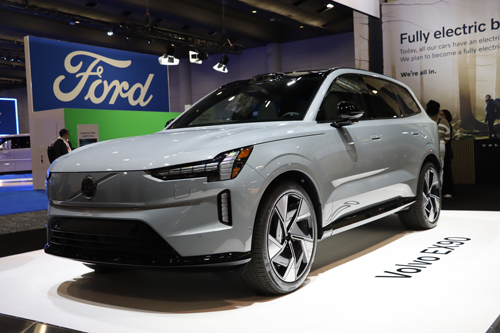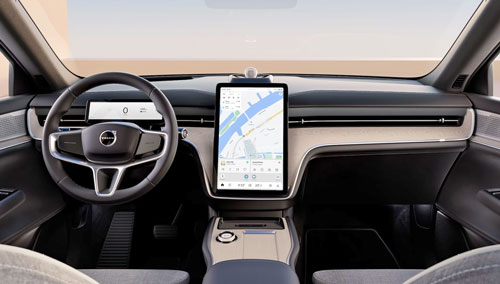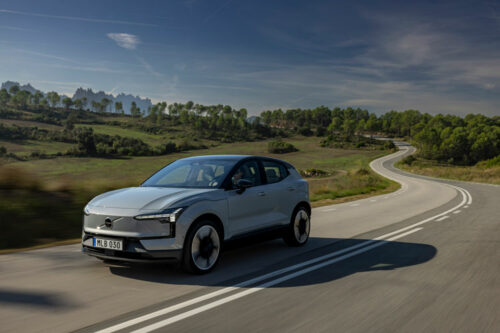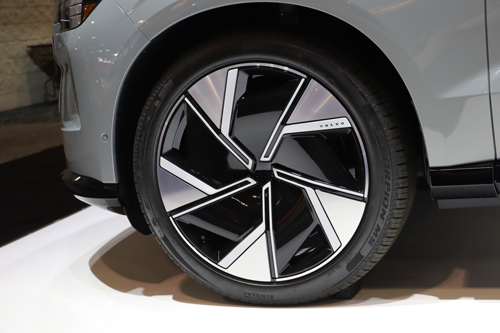Power Brokers: Matt Girgis, Managing Director of Volvo Cars Canada
Volvo is about to embark on a new era punctuated by electrification, safety, autonomy and style – and they brought all of that to the 2024 Canadian International Auto Show at the Metro Toronto Convention Centre in the form of the all new EX90 electric SUV.
We caught up with Matt Girgis, Managing Director of Volvo Cars Canada to discuss the EX90, Volvo’s electric future and how electric vehicles could become part of our lives in bigger ways than simply efficiently (and noiselessly) getting to work.

Vicarious: How does Volvo integrate EVs into buyers’ lives?
Matt Girgis: It’s not just about the OEMs. We all have to work together towards this transition. OEMs, retailers, consumers and of course, governments.
We need to get consumers comfortable with not just the charging infrastructure, but also charging at home – (which) is different now. We’ve adopted the North American Charging Standard (NACS) now – once we have the adapter functionality (for our vehicles), we’ll be able to flip the switch pretty quickly, even in pre-existing EVs – and we have a partnership with Qmerit, which also makes it easier for consumers to charge at home. (Qmerit is a level II home charger manufacturer)
V: And how are Volvo owners responding to this new electrified life?
MG: Our sales of electrified cars more than doubled from 2022-23, so we’re seeing demand there.
In April of 2022, we implemented a new sales model called ‘The One Price Promise’ on our EVs. That’s a negotiation-free, transparent process where you can purchase the car both in-store and online. It removes the friction of haggling and negotiating.

V: But the dealer experience remains important?
MG: I would say the consumer experience is the most important and the enabler for that is the best possible experience with the OEM and the dealer, combined. It’s about (Volvo) and the dealers working together to make sure we’re providing consumers with an omnichannel experience regardless of how they want to interact with us.
V: Is it partly on the dealers to educated consumers on electrification?
MG: Absolutely. We have our trainers with our retailers to train them up on all the new products, so the dealers are executing this together with us. In order for them to get up to speed there was quite a bit of training that’s been involved not just from April of ’22 (when the One Price Promise was originally implemented) but even before that. I would say it was a very collaborative effort between us and the dealers to tackle this issue.

V: When it comes to electrification, do dealers have to be a little more educational now for consumers?
MG: In general, consumers are much more qualified and informed when they buy, regardless of the powertrain. Whether you’re talking about a mild hybrid, or a gas car or a fully electric car, you need to be prepared to discuss with the customers on the terms that they want. Consumers are coming in very informed about the tech, so that of course takes training (for our dealers).
V: Does the new EX90 start a new era for Volvo?
MG: This is a new era of safety and technology for us for sure. This year we’re coming out with the EX90 but we’re also coming out with the EX30 SUV. That’s a smaller SUV, so we’re going to be able to take care of all the bookends of electrification.
V: What are some of the staples of Volvo products going forward?
MG: The interior has new recycled materials with Noridco, a recycled material that we use in the vehicle on all of our new upholstery. The vehicle is also much more flush, much more sleek right down to the wheels. You can see the LIDAR at the front and the LIDAR in combination with our sensors, our cameras and our radar creates a very safe experience around the car. For us, safety is as important as it’s ever been since we introduced the seatbelt and by offering LIDAR as standard on this car, it’s kind of the evolution there.

V: What are some of the highlights of the EX90 in particular?
MG: We’re in an SUV market, so obviously we’re introducing a new SUV with our Scandinavian design. It’s also an electric vehicle with up to 480 km of range, bidirectional charging capabilities – the ability to not just absorb energy, but also to send it back to not just the grid, but to other vehicles. In the future, vehicles will work to help triage energy (through bi-directional charging). You will (also) have the capability to send energy from the car to your house.
(There’s a) brand new infotainment system with a 13.5-inch screen; people want to be able to interact with their personal ecosystem in their car. Partnering with Google (by adding Google Built-In tech) really helps with that.
We’re very proud of this vehicle and we feel like it embodies everything that we stand for: premium Scandinavian design, safety, technology and innovation – it checks all the boxes.
V: What about plug-in hybrid electric vehicles (PHEVs)?
MG: We have a plan to continue to offer them in our portfolio up until 2030. One of the tools (to help reduce range anxiety) is PHEVs. So if you’re not ready to make the full step into full electrification, we offer a full range of PHEVs averaging about 60 km on range in order to help that journey. Last year, 35 per cent of our sales were a combination of fully electric and plug-in hybrid. There’d similar amounts of volume between PHEV and electric.



